STAT3âA Gene Flipping the Switch on Height VariationPosted by Candy Swift on February 7th, 2022 Some people are unsatisfied with their height and wish they could be taller. Unfortunately for most adults, there is not much that can be done to increase height. However, recent research shows that gene therapy might help adult grow taller by restoring growth plates. The IL-6 protein family has been linked to inflammation, arthritis, autoimmune diseases and even cancer. However, a new study reveals the importance of IL-6 and related genes for maintaining and regenerating cartilage in joints and growth plates that promote bone growth in children. A research paper, published in Communications Biology on January 17, 2022, titled gp130/STAT3 signaling is required for homeostatic proliferation and anabolism in postnatal growth plates and articular chondrocytes, demonstrates that the IL-6 family is required to maintain healthy growth and function of skeletal stem and progenitor cells as well as joints and the spine. The study establishes a link between inflammation and regeneration and may explain why stem and progenitor cells are depleted in chronic inflammation. In this study, the first author, Nancy Q. Liu from the University of Southern California, and her colleagues took a closer look at a key gene activated by IL-6 called STAT3. In laboratory-cultured human cells and mice, the scientists demonstrated that STAT3 is critical for the proliferation, survival, maturation and regeneration of cartilage-forming cells within joints and growth plates. When the gene stops functioning, chondrogenic cells become increasingly abnormal over time, resulting in premature fusion of growth plates, underdeveloped bones, and mild degeneration of articular cartilage. When mice lacked a protein called glycoprotein 130 (gp130), they experienced the same problem, the scientists were able to restore the normal growth plate by overactivating STAT3, although this also led to cartilage overgrowth, which led to other bone abnormalities. Interestingly, the researchers noticed a significant gender difference: females experienced more severe cartilage and bone changes than males when STAT3 ceased to function. To understand why, the researchers altered estrogen levels in mice and lab-cultured porcine chondrocytes. In both cases, estrogen increased the amount and activity of STAT3, suggesting that females may be more dependent on the gene. Scientists from Creative Biolabs commented, \"this study has clinical implications for the use of existing drugs that inhibit STAT3 to suppress inflammation in autoimmune diseases, demonstrating that these drugs may also interfere with growth and regeneration. In turn, it also demonstrates that in the future it may be possible to develop a highly targeted gene therapy with the potential to regenerate articular cartilage.\" Creative Biolabs is a leading service provider on one-stop gene therapy development services, covering gene delivery systems development, gene editing, potency tests, safety and toxicology analysis, etc. In addition to STAT3, researchers have already identified hundreds of other genes involved in rare disorders that have an extreme effect on height. These genes include FBN1 for acromicric dysplasia, geleophysic dysplasia, Marfan syndrome, GH1 for isolated growth hormone deficiency, and GPC3 for Simpson-Golabi-Behmel syndrome. By studying the dramatic effect that altered versions of these genes have on height, we can better understand the complex interactions among genes that contribute to height. Like it? Share it!More by this author |


